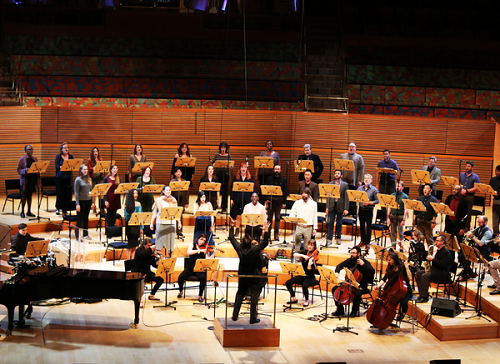 United States Reid, Riley: wild Up (instrumental ensemble), Los Angeles Master Chorale / Grant Gerson (conductor), Walt Disney Concert Hall, Los Angeles, 13.5.2018. (DD)
United States Reid, Riley: wild Up (instrumental ensemble), Los Angeles Master Chorale / Grant Gerson (conductor), Walt Disney Concert Hall, Los Angeles, 13.5.2018. (DD)

Ellen Reid – dreams of the new world (world premiere)
Terry Riley – In C
The intrepid Los Angeles Master Chorale, under the determined direction of Grant Gerson and joined by the contemporary instrumental group wild Up, presented the much-anticipated world premiere of Ellen Reid’s dreams of the new world. Over a complex and highly varied 45 minutes, composer Reid takes her auditors on a figurative trip through time, place, space and culture. It’s an ambitious musical/vocal journey that traverses a broad swatch of American history and an equally broad spectrum of musical styles and influences. Reid is nothing if not an original voice, sure and polished.
In composing dreams of the new world, Reid worked with a librettist, Sarah LaBrie, and a Yale sociocultural anthropologist PhD candidate, Sayd Randle, to create a poetic narrative that moves from 1890s Memphis through the Houston oil boom and bust of the 1970s. It ends with an invocation of the horizon of the future, the ‘new world’ that is not of this world, but one imagined in the dreams and hopes of scientific aspiration and space travel.
The three movements of this quasi-choral symphony are neatly linked through the selected text and original musical ideas, and the linkage underscores both the evocation of hopes for the future and the grim reality of the past. Robert Church is the subject of the first section, ‘Memphis 1890/Freedom’, which tells the story of a Black man who was a success in life but whose place in history has been largely erased. It was the most defined and narrative-rich portion of the program, with evocations of New Orleans jazz, popular music and a measured, sotto voce spiritual intensity.
Part II, ‘Houston 1970/Prosperity’, contains music that is at times purely industrial, with mechanical bass lines and inhuman harmonies, but the prosperity of the times, and its implied hubris, musically returns listeners to the doleful social legacy of Memphis.
‘Los Angeles 2018/Expansion’ moves the piece in different directions, both geographically and spiritually, through static harmonies inhabited by ghostly melodic figures. This is the expansion outside our earthly confines into the new West, that of outer space. The music becomes infused with a degree of optimism (ending midcourse with a blisteringly loud and cacophonous crescendo), that gradually diminishes as the score moves further and further away from our worldly confines: through Gale Crater, Hellas Planitia, the outer planets and, eventually, to the theoretical Oort cloud.
This is challenging music that demonstrates strength in its construction, variegated textures and exquisite melodies, by a composer with a firm and steady compositional understanding, impeccable ear and keen sense of sonic direction. Let there be more, much more, on the way.
The Master Chorale concluded the concert with a mixed-ensemble version of Terry Riley’s best-known composition, In C. To be sure, all versions of Terry Riley’s In C are mixed: the minimal guidelines are actually part of the aesthetic that gave birth to In C and similar pieces of the period. The composer’s instructions on performing do not define the number of players or music making vehicles (from voice to instrument). When first introduced in 1964, it was something of a happening, and while few things are staler than yesteryear’s happenings, Gerson, his chorus and the players from wild Up delivered a true-to-message version of the classic.
One of the guiding principles of In C is found in its laissez-faire attitude towards the audience. It’s the fourth time I’ve either heard or performed this classic: first time, 1969, in a smoky, cannabis-infected park near UCSB; then in a car trip with three other musicians on a six-hour drive up the California coast to Berkeley; third, at a party for my daughter’s graduating class at Oberlin College. Performance times ranged from 30 minutes to something over four hours. This should provide some context.
If there’s a unifying theme to my experiences of In C, it’s the innocence, lack of technical difficulty or sophistication and general attitude of joy and exuberance. And 36 hours after this latest performance, here’s what I remember: the beating hearts of the marimba and xylophone, the evident fun had by all of the singers, especially as they marched up and down aisles and through the seated audience, three women leaning precipitously over the railings in the upper balcony, a fantastic crescendo ten or so minutes into the hour-long performance, the trombone vacillating slowly from an insistent F to a receptive G, a violinist stopping for a long minute to rest her weary left arm, three members of the Master Chorale surrounding an otherwise occupied brass player, a red-haired, green-clad female mezzo in constant motion even when sitting, ‘bup-bup-bup-bug’ from a pod of male singers and, finally, audience members straddling the line between those engaged in concentrated listening and those who took up reading the concert program, including the real estate ads in the back pages.
And here’s what I got from the concert: a renewed understanding of the vital fluidity of the musical arts, the importance of repetition and the relief of variation (and the other way around), the play of stasis and movement. This may be a piece that’s more fun to perform than to appreciate, but I can think of no place I would have rather been.
Except, perhaps, on stage with the xylophone/marimba players.
Douglas Dutton